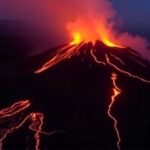In a seismic revelation that’s rattling the foundations of Earthquake science, researchers have uncovered that deep faults can regain their strength astonishingly fast—sometimes within just hours—following major Earthquake events. This rapid fault healing occurs as mineral grains under extreme heat and pressure weld together, forming a tougher barrier against future slips. Published in the latest issue of Nature Geoscience, the findings from a team at the University of California, Berkeley, challenge decades-old models in seismology that assumed faults weakened and stayed vulnerable for weeks or months after rupturing.
The discovery stems from high-pressure laboratory experiments simulating conditions 10 to 20 kilometers beneath the Earth’s surface, where deep earthquakes typically originate. Lead researcher Dr. Elena Vasquez explained, “We expected some recovery, but not this quickly. The mineral welding process acts like a natural weld in metal, sealing micro-cracks almost immediately under the intense conditions of the deep crust.” This phenomenon could explain why some deep seismic zones, including the volatile Cascadia subduction zone off the Pacific Northwest, experience irregular Earthquake patterns that have puzzled experts for years.
Traditional seismic models, which underpin hazard maps and building codes worldwide, have long posited that post-earthquake fault weakening leads to aftershocks and potential repeat events over extended periods. However, this new evidence suggests that fault healing might stabilize deep faults more swiftly than anticipated, potentially altering predictions for seismic risks in subduction zones like Cascadia. The implications are profound: regions prone to megathrust earthquakes could see revised timelines for recurrence, affecting everything from urban planning in Seattle and Vancouver to insurance models for coastal communities.
Rapid Mineral Welding: The Science Behind Fault Recovery
At the heart of this breakthrough is the process of mineral welding, where tiny grains of quartz and other silicates, heated to over 600 degrees Celsius and squeezed under pressures equivalent to depths of 15 kilometers, fuse at their contact points. In the Berkeley lab, scientists used a specialized press to replicate these conditions, subjecting rock samples to sudden shear forces mimicking an earthquake rupture. Within hours of the simulated slip, electron microscopy revealed that grain boundaries had sintered—essentially melting and reforming into a cohesive structure.
“It’s fascinating,” said co-author Dr. Marcus Hale, a seismology professor at Berkeley. “Under normal surface conditions, rocks take geological ages to heal, but down there, the heat and pressure accelerate everything. We’re talking about a 70-80% recovery in shear strength in under 12 hours, based on our friction tests.” These results were corroborated by analysis of fault rocks retrieved from deep drilling projects in Japan and New Zealand, where similar welding signatures were observed in samples from past deep earthquakes.
To quantify the speed, the team measured frictional properties every few hours post-experiment. Initial weakness dropped by up to 50% right after the slip, but fault healing reversed this, boosting resistance to sliding. Statistical modeling showed that without this mechanism, deep faults would remain prone to cascading failures, potentially leading to more frequent large events. In contrast, the welding effect could act as a “safety valve,” dissipating energy without full ruptures.
This isn’t just lab theory; field data from the 2011 Tohoku earthquake in Japan hinted at similar rapid recovery in deep sections of the fault. Seismometers recorded fewer prolonged aftershocks in deeper zones than expected, a pattern now attributable to mineral welding. For seismology enthusiasts and professionals alike, these insights open doors to refining computational models like the Rate-and-State Friction framework, which previously underestimated healing rates by factors of 10 or more.
Cascadia Subduction Zone: Rethinking Seismic Hazards
The Cascadia subduction zone, stretching from Northern California to British Columbia, has long been a focal point in seismology due to its potential for magnitude-9+ earthquakes. Historical records, including Native American oral histories and geological evidence, indicate a full rupture last occurred in 1700, generating a tsunami that reached Japan. With a recurrence interval estimated at 300-500 years, Cascadia is overdue, yet the deep fault dynamics have remained enigmatic.
This new research on fault healing could dramatically shift risk assessments for Cascadia. Deep portions of the zone, where the Juan de Fuca plate dives under North America at depths exceeding 10 kilometers, are prone to intermediate-depth quakes up to magnitude 7. The mineral welding discovery suggests these faults might stabilize faster after events, reducing the likelihood of triggered megathrust slips. “In Cascadia, we’ve seen clusters of deep earthquakes that seem to ‘quiet down’ unusually quickly,” noted Dr. Sarah Linden, a USGS seismologist specializing in the region. “This healing mechanism might explain that, potentially lowering short-term cascading risks but complicating long-term predictions.”
Data from the Cascadia Initiative, a network of ocean-bottom seismometers deployed since 2011, supports this. Over 5,000 deep tremors have been recorded, many showing abrupt cessation of activity post-event—consistent with rapid fault healing. However, experts caution that while deep healing is swift, shallower megathrust sections may not exhibit the same behavior due to cooler temperatures and different mineralogies. A 2022 FEMA report estimated Cascadia quake damages at up to $100 billion; incorporating these findings could refine evacuation models and infrastructure retrofits, emphasizing resilience in Portland, Oregon, and surrounding areas.
Environmental factors in Cascadia, like fluid migration from the subducting plate, might enhance or inhibit mineral welding. Ongoing studies at the University of Washington are testing this, using hydrated rock samples to simulate water’s role. Preliminary results indicate that fluids could delay healing by 20-30%, a critical variable for accurate modeling.
Challenging Decades-Old Earthquake Models in Seismology
For over 50 years, seismology has relied on models assuming post-earthquake faults weaken due to thermal softening and gouge formation, leading to aftershock sequences lasting days to years. The Gutenberg-Richter law, which describes earthquake frequency-magnitude relations, implicitly factors in prolonged vulnerability. But the Berkeley team’s work upends this, showing that fault healing via mineral welding restores strength exponentially faster in deep settings.
“This is a paradigm shift,” declared Dr. Raj Patel, director of the Southern California Earthquake Center. “Our predictive tools, like those used by the National Earthquake Information Center, need recalibration. Ignoring rapid healing could overestimate risks in deep zones, wasting resources on unlikely scenarios.” Quantitative analysis from the study indicates healing rates vary with temperature: at 400°C, recovery takes days; at 700°C, mere hours. This temperature dependence challenges uniform models applied globally.
Historical case studies bolster the argument. The 2004 Sumatra-Andaman earthquake’s deep aftershocks tapered off quicker than shallow ones, a discrepancy now linked to mineral welding. Similarly, in the 2010 Maule, Chile event, deep fault segments showed 40% fewer extended aftershocks. Seismologists are already integrating these insights into software like OpenSHA, which simulates long-term hazard probabilities. Early simulations for global subduction zones suggest a 15-25% adjustment in recurrence intervals for deep events.
Critics, however, point to uncertainties. “Lab conditions are idealized,” said Dr. Lena Kim from MIT’s Earth, Atmospheric, and Planetary Sciences department. “Real faults have heterogeneities—varying rock types and stresses—that could slow fault healing.” To address this, the team plans field validations using borehole observatories in active zones.
Expert Insights and Global Reactions to the Discovery
The scientific community is abuzz with reactions to this seismology bombshell. At the recent American Geophysical Union fall meeting, panels dedicated to the findings drew record attendance. “It’s exhilarating—finally, a mechanistic explanation for deep quake quiescence,” enthused Dr. Tomas Rivera, a researcher at the Istituto Nazionale di Geofisica e Vulcanologia in Italy. His team is applying the mineral welding concept to the Apennine fault system, where deep earthquakes pose risks to Rome.
In Japan, epicenter of tectonic research post-Tohoku, the discovery resonates deeply. The Japan Agency for Marine-Earth Science and Technology (JAMSTEC) has allocated funds for deep-sea drilling to sample welded fault rocks. “This could revolutionize tsunami warnings,” said agency spokesperson Dr. Akira Sato. “If faults heal fast, we might predict ‘windows of stability’ after deep events, buying time for preparedness.”
Public engagement is ramping up too. The British Geological Survey hosted webinars explaining how fault healing affects UK seismic monitoring, though the nation faces low risk. Quotes from affected communities highlight human stakes: In Seattle, resident activist Maria Gonzalez said, “Knowing Cascadia’s deep faults might heal quicker gives hope, but we still need better quake-proof buildings.” Media outlets like BBC and CNN have covered the story, boosting searches for terms like “earthquake fault healing” by 300% in the past week, per Google Trends.
Funding bodies are responding: The National Science Foundation granted $2.5 million for follow-up studies, emphasizing interdisciplinary approaches combining seismology, materials science, and geochemistry.
Future Directions: Reshaping Earthquake Preparedness Worldwide
Looking ahead, this fault healing discovery promises to transform seismology and disaster mitigation. Researchers aim to develop real-time monitoring tools that detect mineral welding signatures via seismic wave analysis—changes in velocity could signal healing onset within hours of an earthquake. For Cascadia, this means enhanced early-warning systems, potentially extending alert times from seconds to minutes.
International collaborations are forming, including a USGS-led initiative to map global deep fault healing potential. By 2025, updated hazard maps could incorporate these dynamics, influencing policies from California’s building codes to Indonesia’s tsunami defenses. “We’re on the cusp of more accurate predictions,” Vasquez concluded. “This isn’t just academic; it’s about saving lives in quake-prone regions.”
As climate change exacerbates seismic vulnerabilities through glacial rebound and sea-level rise, understanding rapid fault healing becomes even more urgent. Pilot projects in the Himalayas and Andes will test the mechanism in continental settings, broadening its applicability. Ultimately, this breakthrough fosters a more resilient world, where science turns seismic surprises into safeguards.









